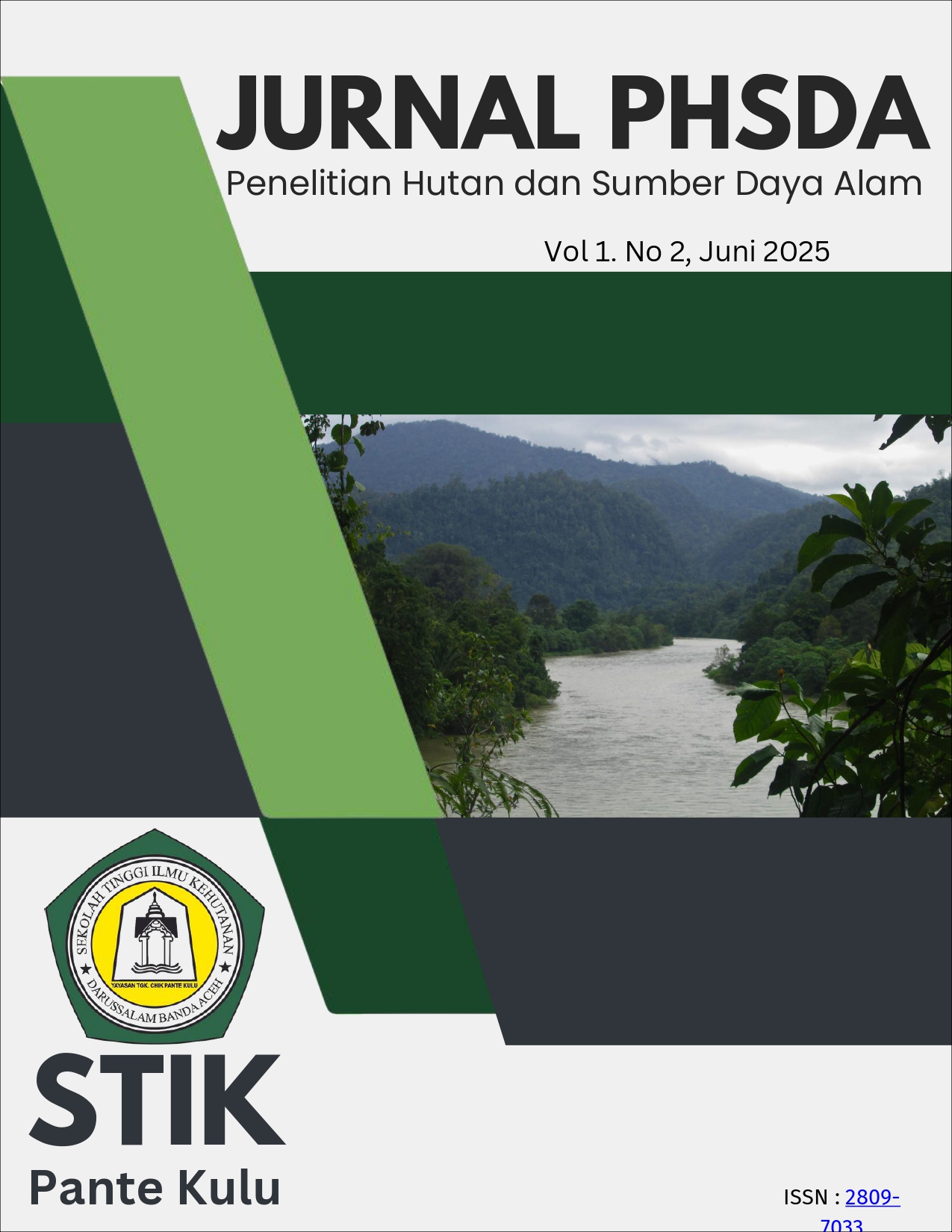Village forest rehabilitation pattern with multipurpose tree species (MPTS) in gampong lutueng, mane subdistrict, pidie district
POLA REHABILITASI HUTAN DESA DENGAN TANAMAN MULTI PURPOSE TREE SPECIES (MPTS) DI GAMPONG LUTUENG KECAMATAN MANE KABUPATEN PIDIE
DOI:
https://doi.org/10.64315/v6w4w850Keywords:
Pattern, Rehabilitation, Forest, Village, Multi Purpose Tree Species (MPTS)Abstract
One sustainable forest management system is planting Multi Purpose Tree Species (MPTS), in social forestry with a village forest rehabilitation pattern. This research aims to determine: (1) biophysical conditions of the land, (2) silvicultural techniques, MPTS as a rehabilitation plant and of economic value to the community, and (3) schemes, actors and systems of the Putroe Ijo Village Forest Management Institute (LPHD) in Gampong Lutueng . This research is qualitative research with a descriptive type. The research results show: (1) Putroe Ijo Village Forest has a cover area of 471 ha or 20.74%, consisting of bushes, dry land farming mixed with bushes and dry land farming (moorland), which is planted with annual crops (2) Condition The biophysical land area of the Putroe Ijo Village Forest covering an area of 190 ha or 8.4% is open and critical, making it prone to erosion and landslides. This area has been opened to become a people's garden in the form of moorland, with a steep/slightly mountainous slope (25-<40%). (3) Silvicultural techniques for planting MPTS in the Putro Ijo Village Forest: (a) Plant types consist of: Durian, Petai , Jengkol and Avocado, (b) plant maintenance, inspection of work and evaluation of planting, (c) Planting is carried out randomly using a system of open paths and plates, and (d) Plant maintenance includes replanting and watering; (4) The majority of the community chose support or approval as much as (92.5%), if the Multi Purpose Tree Species (MPTS) plant was used as a rehabilitation plant, this was because the community had felt the impact of the criticality of the Putroe Ijo Village Forest; and (5) The Village Forest Scheme is part of the Social Forestry Scheme, where state forests whose management rights are carried out by the Gampong Lutueng community, through the Putroe Ijo Village Forest Management Institute (LPHD).
References
Ambarwati, M. E., Sasongko, G., Therik, W. M. A. 2019. Peran Perhutani Dalam Penyelesaian Konflik Tenurial pada Kawasan Hutan: Studi Kasus RPH Ringinpitu BKPH Tanggung KPH Semarang. Jurnal Studi Pembangunan Interdisiplin. 28 (2): 88-113.
Ardyanny, F., Santoso, B., Cahyaningtyas, I. 2020. Aspek Hukum Model Pengelolaan Hutan Bersama Masyarakat (PHBM). Notarius. 13 (1): 341-354.
Arifandy, M. I., Sihaloho, M/ 2016. Efektivitas Pengelolaan Hutan Bersama Masyarakat Sebagai Resolusi Konflik Sumber Daya Hutan. Jurnal Sosiologi Pedesaan. 3 (2): 147-158.
Asmin., Darusman, F., Ichwandi, D., Suharjito, I., Didik. 2017. Modal Sosial Dalam Pengelolaan Hutan Berbasis Masyarakat (PHBM) di Sumatera Barat. [Disertasi]. Institut Pertanian Bogor (IPB). 75 p.
Ayuniza, S., Herwanti, S., Wulandari, C., Kaskoyo, H. 2020. Kontribusi Komposisi Tanaman Agroforestri
Terhadap Pendapatan Petani Kelurahan Pinang Jaya Kota Bandar Lampung. Jurnal Tengkawang. 10 (2): 123-132.
BPS Kabupaten Pidie. 2022. Kabupaten Pidie Dalam Angka. Badan Pusat Statistik Kabupaten Pidie. Sigli. 424 p.
Budiarta, I. G. 2020. Identifikasi Potensi Lahan dan Fungsi Kawasan untuk Pengembangan Kawasan Budidaya Pertanian Lahan Kering di Daerah Aliran Sungai Buleleng. Jurnal Environment & Mapping (ENMAP). 1 (1): 1-10.
Dewi, I. N. 2019. Kemiskinan Masyarakat Sekitar Hutan dan Program Perhutanan Sosial. Info Teknis Eboni. 15 (2) : 65 -77.
Ekawati, S., Suharti, S., Anwar, S. 2020. Bersama Membangun Perhutanan Sosial. Cetakan Kesatu. IPB Press. Bogor. 122 p.
Evizal, R., Prasmatiwi, F. E. 2021. Review: Pilar dan Model Pertanaman Berkelanjutan di Indonesia. Jurnal Galung Tropika, 10 (1): 126-137.
Fitriyani, A., Riniarti, M., Duryat, D. 2020. Inventarisasi Hasil Hutan Bukan Kayu pada Tanaman MPTS di Hutan Desa Sukaraja KPH Rajabasa. Gorontalo Journal of Forestry Research. 3 (1) : 1-10.
Downloads
Published
Issue
Section
License
Copyright (c) 2025 Sartika Sartika (Author)

This work is licensed under a Creative Commons Attribution-NonCommercial-ShareAlike 4.0 International License.









